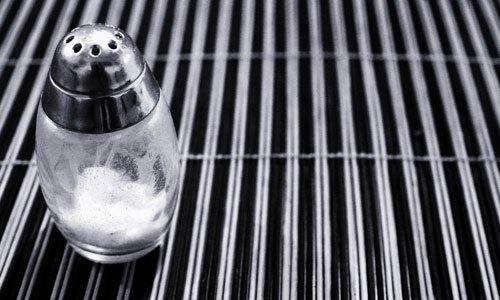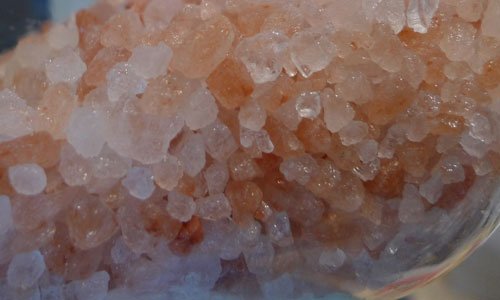We do the best we can to eat well, and that often means limiting the amount of fat we use in cooking. The problem is that fat equals flavor, and we need to replace the flavor that fat provides.
We often turn to exotic salts and seasoning blends in search of a replacement, but they can present their own set of problems. Let’s look at the importance of real salt, how to use herbs, and some easy recipes for homemade blends.
The Chemical Problem
They’re cheap, fast and easy—what’s not to love? But, there are actually two major problems with what you can buy pre-made in the megamart.
First, there are all sorts of chemicals used to increase the shelf life of seasoning mixes, some less reputable than others. The most obvious chemical to avoid is one of the most potent neurotoxins ever created, monosodium glutamate (MSG).
While your local Chinese restaurant may boast that it doesn’t use MSG, you can’t be as sure with a seasoning you buy at the market unless you read the labels.
The laundry list of problems MSG causes are no surprise to many people, ranging from mild headaches to brain lesions.
Despite the fact that this substance is dangerous, you can find it on the shelf at your grocery store in the form of a product called “Accent.” MSG is at the top of my list of things to avoid, it’s simply a “never” for us.
Even if MSG isn’t listed in a food’s ingredients, be on the lookout for things like autolyzed yeast, yeast food, calcium caseinate, and glutamate. Don’t be fooled by the industry’s attempts to keep you in the dark!
The Salt Fleecing

Next, the salt contained in seasoning blends is sub-par. I don’t know about you, but after I eat restaurant food, I tend to wake up swollen like a sausage the following day.
I used to think it was because we use less salt than most people do, and that’s true, but it took a long time before I realized the real reason. We use Real Salt, not iodized kosher salt from the grocery store.
Now, I often talk about the importance of iodine, but I want to emphasize how much our bodies need the natural iodine found in natural salts.
Regular sodium chloride is bad for the heart. It deposits uric acid in the joints and the bones, causing kidney stones, gall stones, gout and arthritis.
Make no mistake, the body needs salt. When we don’t have enough good salt in the body, we get achy, irritable and crampy. The refined salt at the grocery store won’t help these conditions much, if at all.
What Are Real Salts?

If there’s a “good, better, best” in terms of salt, sea salt would have to be my “good.” The issue I have is that regular sea salt is often snowy white, meaning that all of the minerals have been bleached out.
“Better” would be Real Salt, which is what we use in our house. It’s mined in Utah, and has 55 trace minerals, including natural iodine. Using Real Salt and consuming sea vegetables will give you a perfect amount of iodine to nourish your body.
“Best” would be Original Crystal Himalayan Salt (OCHS), but it’s not cheap at almost $15 per pound. Real Salt is just less than $5 per pound.
Whichever salt you choose to use, you can make a solution of salt in water called “sole.” Salt can only saturate water to a 27% concentration, so if you place a great deal of salt in water, it will only dissolve to that saturation point.
You know that your water is fully saturated when there is salt left in the bottom of the glass after being left to soak overnight.
What you’ve created is your saltwater solution, called sole. You should add 1 teaspoon of this solution to your first pint of water in the morning. It’s a fantastic way to restore your body’s alkalinity, as well as giving yourself a huge array of minerals right off the bat each day.
Seasoning Recipes
Salt and the Human Body
- Salt helps maintain a healthy acid-base balance, absorbs potassium, and helps protect against water intoxication.
- Excess salt contributes to high blood pressure, making one higher at risk for stroke and heart disease.
- As this information suggests, consuming the proper amount of salt is vital to the health of the human body.
“They” Said
- Sea Salt: Make the Switch
- How Much Salt is Too Much?
- Homemade Seasoned Salt
Besides the fact that store bought seasoning blends are full of junk ingredients, you’re paying an awful lot for what amounts to mostly salt and pepper.
If you devote a couple of hours to making several seasoning blends that your home uses most often, you’ll have a healthy, tasty selection of spice mixes to turn your boring chicken into something great.
Salsa Seasoning Mix
- 1/3 cup dried cilantro (optional, better to use fresh where available)
- 1/3 cup each minced onion, chili powder (preferably chilis ground in a blender instead of the powder)
- 1/4 cup each cumin, Real Salt, and paprika
- 2 tsp. each garlic powder, dried lemon zest, red pepper flakes (more if you like it hot)
Mix with chopped tomatoes and onions to taste.
Greek Seasoning Blend
Modified slightly from Recipes.net
- 2 tsp. Real Salt
- 2 tsp. dried oregano
- 1 1/2 tsp. onion powder
- 1 1/2 tsp. garlic powder
- 1 tsp. non-GMO cornstarch
- 1 tsp. black pepper
- 1 tsp. beef or vegetable bouillon granules
- 1 tsp. dried parsley flakes
- 1/2 tsp. ground cinnamon
- 1/2 tsp. ground nutmeg
Combine all ingredients; store in an airtight container.
Poultry Seasoning
Modified slightly from Recipes.net
- 3 teaspoons dry mustard
- 1 teaspoon garlic powder
- 3 teaspoons onion powder
- 1 1/2 teaspoons white pepper
- 1 teaspoon dried thyme
- 1/2 teaspoon dried basil
- 3 teaspoons paprika
Mix together and sprinkle on chicken or turkey.
Middle Eastern Spice Mix
From Recipes.net
- 1 tablespoon cumin
- 1 teaspoon cardamom
- 1/2 teaspoon allspice
- 1/2 teaspoon coriander
- 1/2 teaspoon cloves
- 1 teaspoon freshly ground pepper
- 1 teaspoon red pepper flakes, crushed
- 1/2 teaspoon ginger
- 1 teaspoon turmeric
- 1 tablespoon paprika
- 1 teaspoon cinnamon (or ½ tsp if you don’t like strong cinnamon flavor)
Combine well and store in jar. Use to season rice, lentils, meats, etc.
Chinese Seasoning
From Recipes.net
- 1/4 cup ground ginger
- 2 tablespoons ground cinnamon
- 1 tablespoon allspice
- 1 tablespoon crushed aniseed
- 1-1/2 teaspoons ground cloves
In a screw-top jar, combine all ingredients. Cover tightly, shake until well mixed. Keep in a dry place. This is a great replacement for five spice, which is often difficult to find in the store.
Yield: 1/2 cup
Lemon Pepper Seasoning Mix
From Recipes.net
- 1 c. ground black pepper
- 1/3 c. dried lemon peel
- 3 tsp. coriander seeds
- 1/4 c. dried minced onion
- 1/4 c. dried thyme leaves
Stir all the ingredients together and store in airtight jars.
Homemade Extracts
Finally, it’s a great idea to make your own extracts for baking. Besides the fact that they’re cheap, they taste fantastic and make large volumes in a short amount of time.
I start by buying 1 liter of vodka. Depending on how much baking you do, you’ll want to make half of it vanilla and then divide the other half liter for drinking or maybe a few small quantities of citrus extracts.
Half a liter lasts around a year for my family of five, but I suspect that I bake more frequently than most. To make vanilla extract, buy whole vanilla beans. I typically buy organic beans by the dozen from Ebay, and reserve the other half dozen for special treats like coconut milk ice cream.
Slit the beans down the middle and scrape the inside of the pods with the point of a knife. Take the vanilla and place it into the bottle with the vodka. Then cut the beans into 2-3 inch pieces and toss them in as well.
Let the mixture sit in a cool dark place for a minimum of eight weeks, shaking it every other day or so. You’ll notice that the vodka will change from clear to dark as the beans infuse.
You’ll know the extract is ready when you smell more vanilla than alcohol upon opening the bottle.
To make citrus extract, simply use a paring knife or potato peeler to remove the skin (but not the pith) from a small organic lemon or orange. Place the peels in a pint of vodka and follow the same procedure as making vanilla extract.
You could also try this with tangerine, lime, or grapefruit, but you’ll have to be creative to use them. Most recipes call for lemon or orange, but you can add a few drops to homemade ice creams, cookies and cakes for a unique taste experience.
I hope you’ve gotten some new recipes today to make your seasonings both healthy and cheap. Bon appetit!